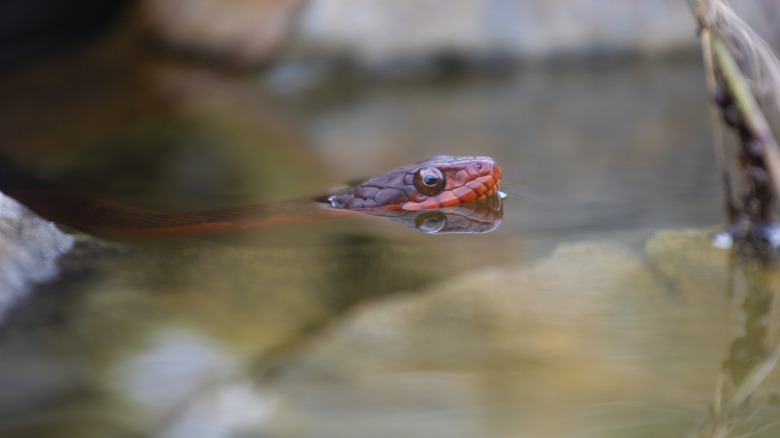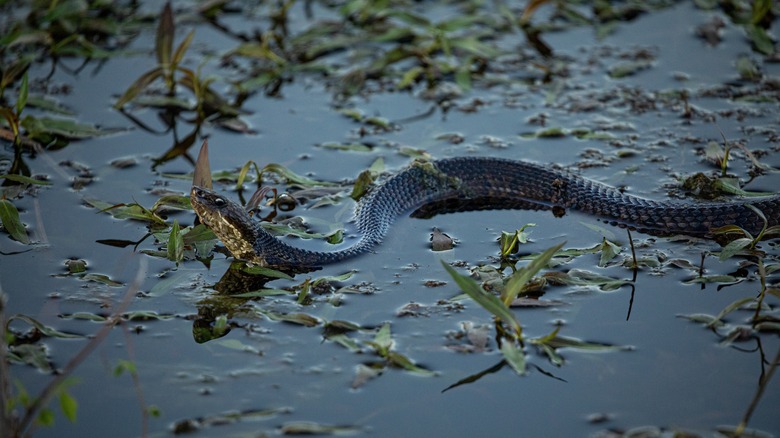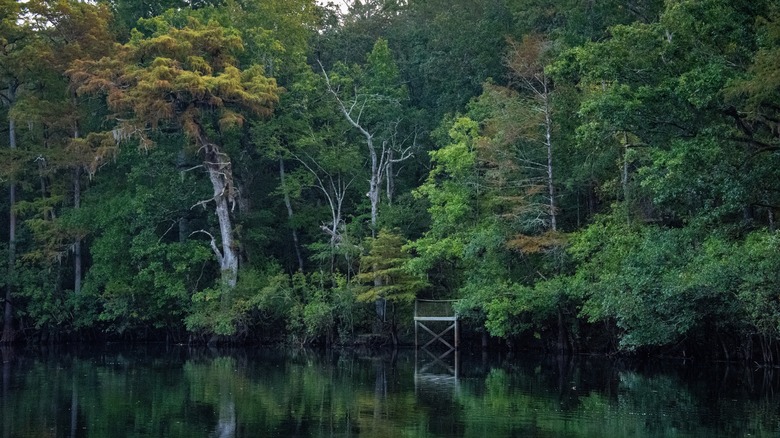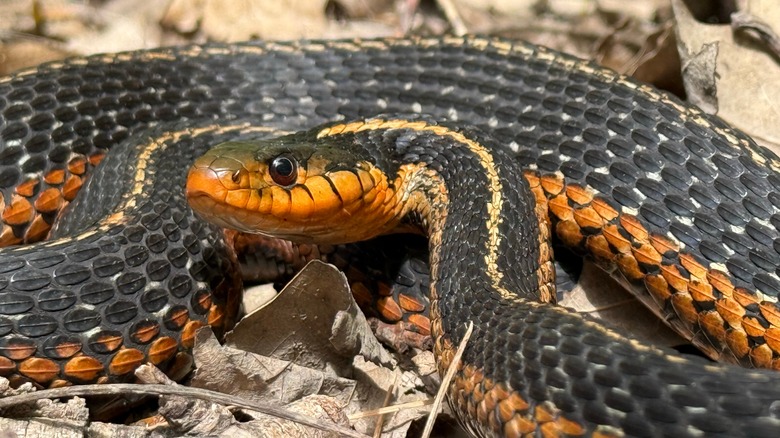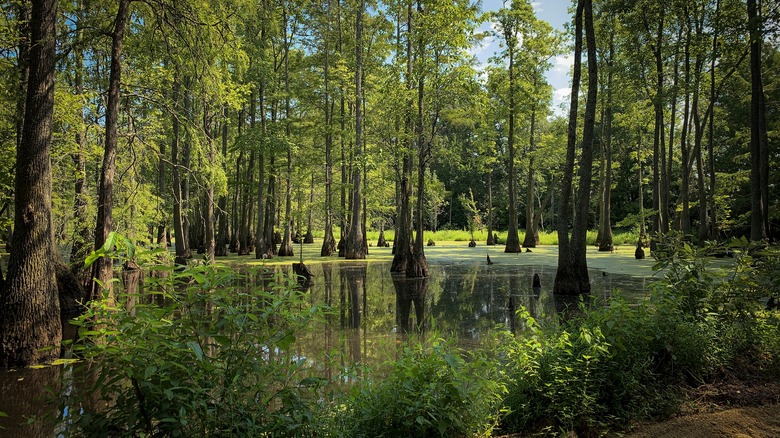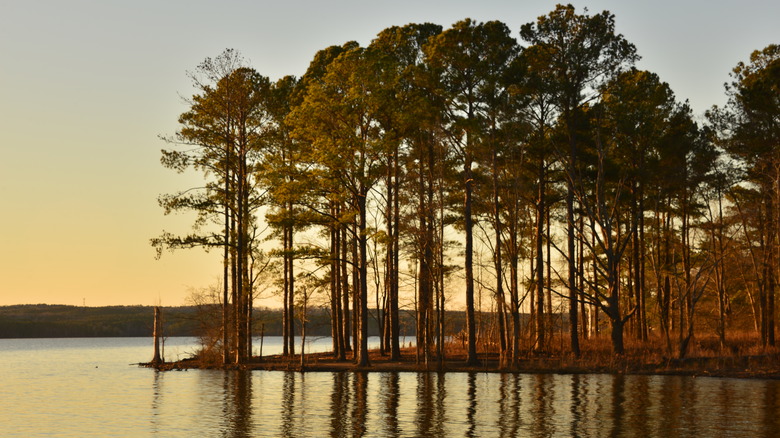North Carolina's Most Snake-Infested Bodies Of Water You Might Want To Avoid
From the breathtaking Blue Ridge Mountains to secluded hiking havens in Great Smoky Mountains National Park to the Outer Banks along the coastal seaboard, the Tar Heel State is full of diverse landscapes, natural features, and unique wildlife. North Carolina loves its natural resources, and there's nothing more quintessentially "Carolina" on a hot summer day than finding a swimming hole and taking a refreshing dip. Across coastal swamps, lakes, and meandering rivers, the state offers abundant natural swimming and paddling opportunities. But in warmer months, you may find yourself sharing the water with snakes.
Most snake species pose no threat to humans and help control rodents, supporting healthy ecosystems. But in North Carolina's many waterways and marshy habitats, snakes are something to watch for. The state is not the worst in the U.S. for snakes — that dubious honor likely goes to Florida, which boasts an infamous reptile population and numerous snake-infested waters. Fortunately, though, most snakes in North Carolina aren't even aquatic, and only six of the state's 37 snake species are venomous. Two — the eastern diamondback rattlesnake and the eastern coral snake — are listed as endangered in North Carolina and are rarely seen.
In the rivers and swamps of the southeastern Coastal Plain, you might encounter venomous cottonmouths — aka water moccasins — in still or slow-moving water with dense vegetation. Some of the most common Carolina snakes — such as the eastern worm, black racer, and various rat snakes — are non-venomous. Among water snakes, the harmless brown water snake, plain-bellied or red-bellied water snakes, banded water snakes, and northern water snakes thrive in swampy areas.
While you may not want to swim with snakes — venomous or not — remember: they don't want to swim with you either. Leave them be to thrive in their natural environment — where you're just a guest.
Lumber River
The Lumber River is a 115-mile blackwater river and former canoe trail, named for its historical role in shipping timber, a major 18th-century industry. Today, it's popular for fishing and paddling, and its banks teem with wildlife, including beavers, minks, muskrats, and otters; wild turkeys and ducks in abundance; pine cypress and juniper trees draped in Spanish moss and Virginia creeper vibes, as well as the rare pitcher plant and Venus flytrap. Copperheads and rattlesnakes have been spotted on land, but aquatic snakes in particular are often spotted here, and the cottonmouth is among them.
The most likely venomous aquatic snake you'll encounter in North Carolina is the cottonmouth. This pit viper is known for its defensive display — when threatened, it opens its mouth wide to reveal a stark white interior, intending to startle predators. Some do stand their ground, so it's best to give them space. They are primarily active from April through October. Adult cottonmouths range from light olive to brown with dark cross-band patterns; juveniles typically have bright yellow or green tail tips. Copperheads, which are non-aquatic, sometimes occur in woods or along trails, and are considered the state's most commonly encountered venomous snake. While not as venomous as the rattlesnake or coral snake bites, cottonmouth bites are serious and require immediate medical treatment.
Black River and the Cape Fear Basin
Just 15 miles above coastal Wilmington, the Cape Fear River is joined by the Black River, a slow-moving, blackwater tributary flowing through diverse riparian zones where snakes thrive — from the Piedmont into the Coastal Plain. Along with other waterways, they drain into the Cape Fear River Basin, the largest and most ecologically diverse watershed in the state, at 9,000 square miles.
The Black River takes its name from its dark, tannin-rich water caused by decaying vegetation. It is a paddler's paradise, as it winds through floodplain forests, ancient bald cypress groves, the Three Sisters Swamp, and oxbow lakes — minimally developed land that creates ideal snake habitats. Its location in the southeastern Coastal Plain makes it prime cottonmouth territory, though it shares its waters with several other snake species. Because of its dark, swampy nature, the Black River is considered one of the most snake-rich rivers in North Carolina. As a popular waterway for kayakers and swimmers, caution is warranted around tall shoreline vegetation, hollow logs, and riverbanks. In summer 2025, parts of North Carolina experienced higher-than-average temperatures, and locals reported seeing more snakes than usual — particularly cottonmouths and copperheads — along portions of the Black River.
You may also spot non-venomous water snakes such as the brown water snake, northern water snake, or plain-bellied water snake, which are common in swampy creeks and backwaters. Sometimes snakes bask on branches that overhang the water, so if you're paddling, keep a watchful eye overhead.
Lake Waccamaw, Waccamaw River, and the Green Swamp
Here you get a three-for-one because these bodies of water are somewhat interconnected — and they all have snakes! Waccamaw Lake is a natural lake in Columbus County, about 40 miles west of Wilmington. It's one of the largest lakes in the region and is rife with wildlife and a diversity of topography, from limestone bluffs to sandy beaches and swamplands.
The lake is also near the Green Swamp, home to alligators and regionally unusual diamond-backed rattlesnakes, and drains into the Waccamaw River, which flows across South Carolina to Winyah Bay. This stretch creates a massive contiguous wildlife habitat. The Waccamaw River is also considered one of the most pristine blackwater rivers in the Southeast.
Plenty of non-venomous snakes, such as eastern rat snakes and eastern garter snakes — which frequent areas near water — inhabit the area. Though usually harmless to humans, the eastern garter snake (Thamnophis sirtalis) has an atypical bodily organ that secretes a substance toxic to rodents. The Waccamaw Lake is also home to cottonmouths and copperheads — which you're less likely to see, but it's important to stay watchful and know how to react and avoid common mistakes people make when bitten by venomous snakes.
The Great Dismal Swamp
Of course, a list of snake-filled bodies of water in North Carolina would be remiss without a mention of the Great Dismal Swamp, a massive, 750-square-mile cartoonish morass of dense marshland and forest that spills across the northeastern corner of the state into Virginia. Here you'll find a healthy mix of 18 non-venomous snakes and at least three venomous snakes: the cottonmouth, the canebrake aka "timber" rattlesnake, and copperheads.
Timber rattlesnakes are primarily found in the Blue Ridge Mountains of Western North Carolina, but even there, the numbers are dwindling, and you're more likely to see non-venomous snakes or copperheads. And although rattlesnakes tend to be more elusive and land-driven, be cautious of any tall grass and wetland areas. It's always better to see a cottonmouth sending its mouth-gaping warning so you can pivot in time to avoid a bite. Again, keep an eye on the tree branches overhead, too, especially if you're paddling through.
Non-venomous Northern black racers are likely the most common snake you'll find in the Great Dismal, but they're joined by all kinds of rainbow, rat, hognosed, worm, king, and a multitude of other primarily non-aquatic, harmless snakes. Northern brown and black water snakes are most likely to be found in the waterways, and the semiaquatic red-bellied water snakes may also be found along the swamp's tall grasses, overhanging tree branches, and waterways.
Jordan Lake
Just 30 minutes outside of downtown Raleigh lies a tranquil state park and recreation area called Jordan Lake. The forested preserve surrounds roughly 150 miles of shoreline on this artificial lake, with picnic and camping areas, boat ramps, and multiple sand beaches and swimming zones. Jordan Lake is popular both for its size and its proximity to the Raleigh-Durham area — an easy day-trip that feels like you've gone much further into the wilderness. But where there's wilderness, there are bound to be snakes. Jordan Lake's ecosystems include rocky shorelines and marshy areas, which are favorable for snakes.
In the lake, you can find the northern water snake and eastern rat snake, the latter of which are good swimmers and often hunt underwater. Keep an eye open along heavy foliage or rock outcroppings near the water's edge, where an eastern rat snake may be sunbathing — or climbing trees. There are no established cottonmouth populations in Wake County, so if you do see a water snake, it is almost certainly not venomous.
Hognose snakes have been spotted in the wooded areas of Jordan Lake, so you're more likely to catch a glimpse of one when hiking. They're not venomous to humans, and their fangs are located toward the back of the mouth, but they do have a small, almost cobra-like hood that flares when they're scared or caught off guard. Many are dark in appearance, which can make them seem more intimidating than they are — but best practice is to observe from a distance and avoid handling.
